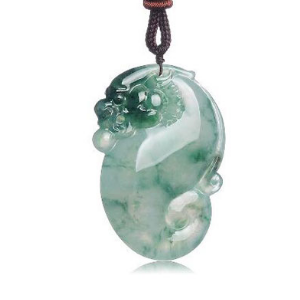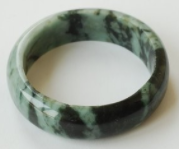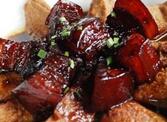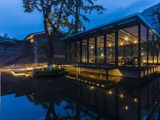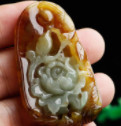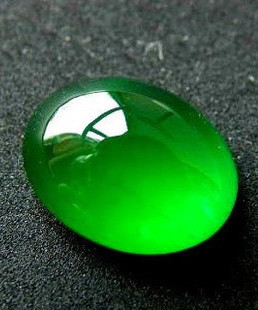Common varieties include Laokeng jadeite, ice jadeite, water jadeite, etc.
Black Ice Ink Painting
Black ice is grey black to dark black jadeite. More than 98% of it is jadeite, which belongs to single mineral rock with compact and fine structure. Black is formed under the surface of the earth when jadeite is formed, and it is often infiltrated by organic carbon.
Black ice raw stones are mainly produced in Myanmar Pagan Mine. Black ice raw materials can also be seen at auctions in Naypyidaw, Yangon and other places in Myanmar.
In the industry, because of its dark texture, it looks like a Chinese ink landscape painting. Old experts also call it "Chinese ink painting kind of jadeite".
Ink green
At first glance, the black is shiny, which can easily be mistaken for the black jade or other black gemstones in Dushan Jade. They are thick black and oily under natural light, but when viewed under transmission light, they are translucent, and green in black, especially the thin flake of ink green, which is pleasing under transmission light. Burmese use "the shadow of a lover" to describe black jadeite, which the Chinese call "Mocui".
Red jadeite
The emerald with bright red or orange red color is easy to see in the market. The color of red jadeite is formed after the formation of jadeite crystal, which is caused by hematite impregnation. It is characterized by bright red or deep red, good red jadeite has good color, glass luster, and its transparency is translucent. Red jadeite products are often middle or low grade goods, but there are also high-grade red jadeite: bright color, fine texture, very beautiful, and is popular with people, with auspicious colors.
Panorama
It is characterized by dark green or blackening under natural light, rough texture and dry water head.
Yellow brown jadeite
The jadeite with yellow to brown yellow or brown yellow color is less transparent. This series of color jadeite products can be seen everywhere in the market. Their colors are also formed after jadeite crystals are formed, and they are often distributed on the red layer, which is caused by limonite impregnation. In the market, the value of red jadeite is higher than that of yellow jadeite, yellow jadeite is higher than that of brown yellow jadeite, and brown yellow jadeite takes the second place. However, there are also cases where the price of jewelry is different from that of conventional jewelry because of people's love and unique characteristics. There are two kinds of yellow jadeite, yellow to brownish yellow, generally called golden autumn variety, which is similar to the crops in autumn harvest season. The brown to brownish yellow is also called sauce glaze variety, and the sauce glaze with color similar to porcelain is also called "zao lao".
Bashan Jade
"Bashan Jade" raw stone is a kind of "brick material" with coarse crystal material, loose structure, dry water and poor bottom, but its color is rich, including lavender, light green, green or blue gray, which is a special jadeite with low grade and minerals such as amphibole and albite.
Dried green seed
Sodium chromite pyroxene (also known as meteorite chromite pyroxene) is impossible to form on the earth, but only found in meteorites.
It turns out that the sodium chromite pyroxene is what Hong Kong experts call dry green jadeite. It is different from ordinary jadeite. Its chemical composition is NaCrSi2O6, its hardness is Grade 5, its refractive index is 1.75, and its specific gravity is 3.5. It has high chromium content, so its color is bright, but its transparency is poor, and its particles are coarse, so experts call it dry green.
The dry green jadeite is thick green and pleasing to the eye, pure and innocent, almost the same as the general jadeite with darker color, and its color is sometimes dark and black. No matter the color is dark or light, because the dry cyanite mainly composed of sodium chromite pyroxene has a relatively low hardness, its color lacks strength and appears dull and weak, which is also one of the obvious differences from jadeite in the general sense. The outstanding disadvantages of dry green jadeite are poor transparency, weak sunlight exposure, rough texture and dry bottom, and dry and rough sound when striking raw stones. Chromite inclusions with metallic luster are often seen on the dry green surface.
Tie Longsheng
Green jade pieces. Its mineral reserves were found in 90 years, and were mined publicly in 94 years. It was nearly exhausted in 2000. The good quality Tielongsheng in the market is particularly rare.
Tielongsheng is a medium grade jadeite with bright green, but different shades, poor transparency, loose structure and columnar crystals arranged in a certain direction, which is often seen in the market. "Tielongsheng" takes the pronunciation of Burmese, which means full green.
Ice seed
The texture is similar to that of the old pit seeds, colorless or less colored. The characteristics of the ice seeds are that the outer surface is very shiny, translucent to transparent, clear like ice, giving people a feeling of ice and jade. If there are flocculent or intermittent veins with blue color in the ice jadeite, it is called "blue flower ice", which is a common variety of ice jadeite. Ice jade is often used to make bracelets or pendants. There is no obvious difference between the value of colorless ice jadeite and that of "blue flower ice" jadeite, and the actual price mainly depends on people's preferences. The so-called ice seed refers to the variety with extremely transparent texture and water spirit, which has the same effect as the golden water bodhi in the colored gemstones, but the difference is that there is no so-called cotton in the good chalcedony, and the texture is more lustrous.
Aquatic jadeite
The texture of water jadeite is slightly thicker than that of Laokeng glass, and its luster and transparency are slightly lower than that of Laokeng glass, which is similar to or equivalent to that of ice. Its characteristic is that the higher the transparency of jadeite, the better the water head. It means that the more compact the internal structure is, the older the internal structure is. The rougher the internal structure is, the more tender the species will be. It is as transparent as water but has soft luster. On the microscopic view of its internal structure, a little "ripple" can be seen, or a small amount of dark cracks and stone lines can be seen. Occasionally, a small amount of impurities, cotton and willow can also be seen. Some experts say that water planted jadeite is light or colorless, and the quality is slightly poor. It is one of the middle and high grade jadeite, and occasionally the top grade.
Flower green jadeite
The color is emerald green and distributed in vein shape, extremely irregular; The texture is thick and thin, translucent. Its background color is light green or other colors. Such as light gray or bean green, its structure is mainly fiber and fine to medium grain structure. The characteristic of the emerald is uneven green. Some are dense, some are scattered, and the colors are dark and light. There is another kind of structure in the flower green jadeite, which is only granular and lacks water sense. Because of its rough structure, the transparency is often poor. Huaqing belongs to middle or low grade jadeite.
Oil green jadeite
It is referred to as oleoresin or oil immersed. Its permeability and luster look oily. It is a medium and low grade jadeite that can be seen everywhere in the market. It is often used to make pendants, bracelets, or ring faces. The green of oleoresin is obviously impure, containing gray and blue components, so it is dull and not bright enough.
Bean seed jadeite
It is called bean seed for short. The bean seed jadeite is a very common variety in the jadeite family.
Old pit planting jadeite
Commonly known as "Laokeng Glass Seed" in the business world, it usually has glass luster, and its texture is fine, pure and flawless, and its color is pure, bright, rich and even emerald green; The crystal grain of Laokeng jadeite jadeite is very fine, so it is extremely difficult to see the "emerald nature" with the naked eye; Laokeng jadeite is semi transparent and transparent under the light, which is the top grade or taste of jadeite.
Violet Jade
This is a kind of purple jadeite with a color like violet flower, which is also called "Chun" or "Spring" in the jewelry industry. The jadeite with "spring color" has high, medium and low grades. It is not necessarily valuable as long as it is violet. It must be top grade. It must also be comprehensively evaluated in combination with quality indicators such as texture, transparency and process level.
The purple on the jadeite is generally not deep. According to the different shades of purple, the jadeite industry divides the purple in the jadeite into pink purple, eggplant purple and blue purple. The pink purple usually has a fine texture and good transparency, followed by eggplant purple and blue purple.
Green emerald with white background
The white background is as white as snow, and the green is very bright on the white background. This variety of jadeite is easy to identify: green is distributed in spots on a white background, with poor transparency, which is opaque or slightly transparent; The jade pieces have fiber and fine grain inlay structure, but mainly fine grain structure; When observed under a microscope (it must be magnified by 30-40 times), the surface is often perforated or uneven.
Most of the varieties are medium grade jadeite, and a few are clear green and white, bright green, good color shape, and very harmonious color and bottom, which can reach medium grade.
Ice waxy jadeite
Ice waxy variety generally refers to a kind of jadeite variety with good transparency and water head, which can reach the level of ice. In order to distinguish ordinary waxy varieties, this kind of variety is also called ice seed bottom melting.
Hibiscus jadeite
It is called Hibiscus species for short. The jadeite of this variety is generally light green, without yellow tone. It is relatively clear and pure green, and sometimes its base is slightly pink.
Horse tooth jadeite
Although its texture is fine, it is opaque, and its surface luster is like porcelain.
Lotus root powder jadeite
Its texture is as delicate as lotus root powder, and its color is light pink purple red (light spring color). It is a good raw material for handicrafts.
Emerald silk
This is a kind of jadeite with good texture and color, which is of medium grade in the market.
Golden silk jadeite
The jadeite jade with yellow and orange color in the shallow bottom is in strip shape, in parallel arrangement with filaments, and has obvious directional structure. Except for its color, other characteristics are the same as that of the jadeite silk. However, the price of gold silk jadeite is usually lower than that of jade silk jadeite.
Dry white jadeite
It is white or light grey white jadeite with coarse texture and poor transparency. The expert of jadeite jade appraises it as: thick, dry and dry. This variety is colorless or light in color, and the boundary between grains can be seen with the naked eye, so it is a low-grade jadeite variety with rough appearance and low use and ornamental value.
Giant jadeite raw stone
On February 9, 2014, a miner found a huge 20 ton jadeite raw stone in Pagan, western Kachin State, Myanmar. As of February 19, 2014, the Myanmar police had carried out emergency deployment in the area to protect the raw stone, and prohibited anyone from looking for jade near the discovery site.
The original stone found here is 18 feet long. Local miners even think that its weight may reach 37 tons, because half of the original stone may still be buried underground. It is reported that the Ministry of Mines of Myanmar will test the raw stone, but its exact value is still unclear.

